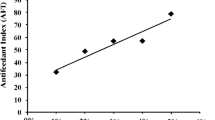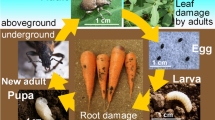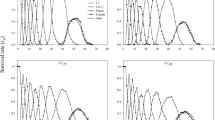Abstract
Petrol and ethanolic extracts of six asteraceous weeds were added to artificial diets to screen for growth inhibition and mortality of the variegated cutworm,Peridroma saucia (Hbn). Petrol and ethanolic extracts ofArtemisia tridentata andChamomilla suaveolens and ethanolic extracts ofChrysothamnus nauseosus andCentaurea diffusa severely inhibited larval growth at five times the natural concentrations. The twoC. suaveolens extracts and the ethanol extract ofA. tridentata were active at the natural concentration (100%) and were further examined at 20, 40, 60, and 80% of this level. Inhibition of larval growth was directly related to concentration for each of the three extracts tested. EC50s (effective concentration to inhibit growth by 50% relative to controls) for the three extracts were 36–42% of the naturally occurring level in the plants. Nutritional indices were calculated for secondinstarP. saucia feeding on the activeA. tridentata EtOH extract and the petrol extract fromC. suaveolens. Addition of the activeA. tridentata EtOH or theC. suaveolens petrol extract to the diet resulted in significant reduction in the relative growth rate of larvae, although theA. tridentata extract was much more inhibitory. Dietary utilization was significantly lower for larvae fed theA. tridentata EtOH extract.
Similar content being viewed by others
References
Beirne, B.P. 1971. Pest insects of annual crop plants in Canada.Mem. Entomol. Soc. Can. 78:124 pp.
Bernays, E.A. 1983. Antifeedants in crop pest management, pp. 259–269,in D.L. Whitehead and W.W. Bower (eds.). Natural Products for Innovative Pest Management (Current Themes in Tropical Science, Vol. 2). Pergamon Press, Oxford.
Brown, D., Asplund, F.O., andMcMahon, V. 1975. Phenolic constituents ofArtemisia tridentata spp.vaseyana. Phytochemistry 14:1083–1084.
Buttkus, H.A., Bose, T.J., andShearer, D.A. 1977. Terpenes in the essential oil of sagebrush (Artemisiatridentata).J. Agric. Food Chem. 25:288–291.
Capinera, J.L. 1978. Variegated cutworm: Consumption of sugarbeet foliage and development on sugarbeet.J. Econ. Entomol. 71:978–980.
Crosby, D.G. 1971. Minor insecticides of plant origin, pp. 177–239,in M. Jacobson and D.G. Crosby (eds.). Naturally Occurring Insecticides. Marcel Dekker, New York.
Crumb, S.E. 1929. Tobacco cutworms. U.S. Dept. of Agriculture Tech. Bull. 88. 175 pp.
Delle Monche, F., Marini Bettolo, G.B., andBernays, E.A. 1984. Isolation of insect antifeedant alkaloids fromMaytenus rigida (Celatraceae).Z. Angew. Entomol. 97:406–414.
Dobrin, G.C., andHammond, R.B. 1985. The antifeeding activity of selected pyrethroids towards the Mexican bean beetle (Coleoptera: Coccinellidae).J. Kans. Entomol. Soc. 58:433–437.
Grainge, M., Ahmed, S., Mitchell, W.C., andHylin, J.W. 1985. Plant species reportedly possessing pest-control properties—an EWC/UH database. Resource Systems Institute, East-West Center, University of Hawaii, Honolulu. Hawaii. 249 pp.
Heywood, V.H., Harborne, J.B., andTurner, B.L. (eds.) 1977. The Biology and Chemistry of the Compositae. Academic Press, London. 1118 pp.
Isman, M.B., andDuffey, S.S. 1982. Toxicity of tomato phenolic compounds to the fruitworm,Heliothis zea.Entomol. Exp. Appl. 31:370–376.
Isman, M.B., andRodriguez, E. 1983. Larval growth inhibitors from species ofPanhenium (Asteraceae).Phytochemistry 22:2709–2713.
Jermy, T., Butt, B.A., McDonough, L., Dreyer, D.L., andRose, A.F. 1981. Antifeedants for the Colorado potato beetle. I. Antifeeding constituents of some plants from the sagebrush community.Insect Sci. Appl. 1:237–242.
Kelsey, R.G., andShafizadeh, F. 1979. Sesquiterpene lactones and systematics of the genusArtemisia.Phytochemistry 18:1591–1611.
Kumar, K., andChapman, R.B. 1984. Sublethal effects of insecticides on the diamondback mothPlutella xylostella (L.).Pestic. Sci. 15:344–352.
Lane, G.A., Sutherland, O.R.W., andSkipp, R.A. 1987. Isoflavonoids as insect feeding deterrents and antifungal components from root ofLupinus angustifolius.J. Chem. Ecol. 13:771–783.
Mabry, T.J., andGill, J.E. 1979. Sesquiterpene lactones and other terpenoids, pp. 502–538,in G.A. Rosenthal, and D.H. Janzen (eds.). Herbivores: Their Interaction with Secondary Plant Metabolites. Academic Press, New York.
Murray, R.D.H., I. Medez, andBrown, S.A. (eds.). 1982. The Natural Coumarins. Wiley-Interscience, New York. 702 pp.
Painter, R.H. 1951. Insect Resistance in Crop Plants. University Press of Kansas. 520 pp.
Reese, J.C. 1983. Nutrient-allelochemical interactions in host plant resistance, pp. 231–243,in P.A. Hedin (ed.). Plant Resistance to Insects.ACS Symposium Series 208. American Chemical Society, Washington, D.C.
Rodriguez, E., Carman, N.J., Vander Velde, G., Mcreynolds, J.H., andMabry, T.J. 1972. Methoxylated flavonoids fromArtemisia.Phytochemistry 11:3509–3514.
Seaman, D.L. 1982. Sesquiterpene lactones as taxonomic characters in the Asteraceae.Bot. Rev. 48:121–595.
Taylor, P.L., andMacbride, B. 1977. Vascular Plants of British Columbia. Tech. Bull. No. 4. University of B.C. Press, Vancouver, B.C. 754 pp.
Villani, M., andGould, F. 1983. Screening crude plant extracts as feeding deterrents of the wireworm,Melanotus communis.Entomol. Exp. Appl. 37:69–75.
Welch, B.L., andMcarthur, E.D. 1981. Variation of monoterpenoid content among subspecies and accessions ofArtemisia tridentata grown in a uniform garden.J. Range Manage. 34:380–384.
Wisdom, C.S., Smiley, J.T., andRodriguez, E. 1983. Toxicity and deterrency of Sesquiterpene lactones and chromenes to the corn earworm.J. Econ. Entomol. 76:993–998.
Author information
Authors and Affiliations
Rights and permissions
About this article
Cite this article
Salloum, G.S., Isman, M.B. Crude extracts of asteraceous weeds. J Chem Ecol 15, 1379–1389 (1989). https://doi.org/10.1007/BF01014837
Received:
Accepted:
Issue Date:
DOI: https://doi.org/10.1007/BF01014837




